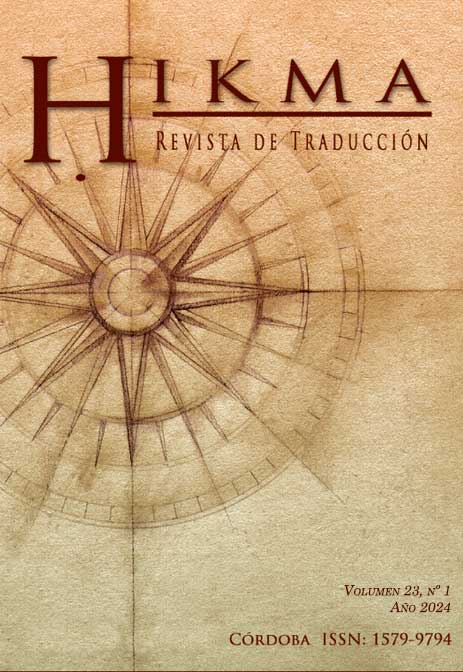ZÁRATE, Soledad. Captioning and Subtitling for d/Deaf and Hard of Hearing Audiences. London, UCL Press, 2021, 154 pp., 978-1-78735-712-9.
Main Article Content
Abstract
Review of the book: Captioning and Subtitling for d/Deaf and Hard of Hearing Audiences.
Downloads
Article Details

This work is licensed under a Creative Commons Attribution-NonCommercial-ShareAlike 4.0 International License.
Authors who publish with this journal agree to the following terms:
1. Authors retain copyright and grant the journal right of first publication with the work simultaneously licensed under a Creative Commons Attribution License that allows others to share the work with an acknowledgement of the work's authorship and initial publication in this journal.
2. Authors are able to enter into separate, additional contractual arrangements for the non-exclusive distribution of the journal's published version of the work (e.g., post it to an institutional repository or publish it in a book), with an acknowledgement of its initial publication in this journal.
3. Authors are permitted and encouraged to post their work online (e.g., in institutional repositories or on their website) prior to and during the submission process, as it can lead to productive exchanges, as well as earlier and greater citation of published work (See The Effect of Open Access).
References
Agulló, B., & Matamala, A. (2019). Subtitling for the deaf and hard-of-hearing in immersive environments: Results from a focus group. The Journal of Specialised Translation, 32, 217-235.
Arnáiz, V. (2012). Los parámetros que identifican el subtitulado para sordos: Análisis y clasificación. MonTI. Monografías de Traducción e Interpretación, 4, 103–132. https://doi.org/10.6035/MonTI.2012.4.5 DOI: https://doi.org/10.6035/MonTI.2012.4.5
De Linde, Z., & Kay, N. (1999). The Semiotics of Subtitling. St Jerome.
Díaz-Cintas, J., & Remael, A. (2021). Subtitling: Concepts and practices. Routledge. DOI: https://doi.org/10.4324/9781315674278
Ivarsson, J., & Carroll, M. (1998). Subtitling. TransEdit.
Ley 13/2022, de 7 de julio, General de Comunicación Audiovisual., 13/2022 Boletín Oficial de Estado, 163, de 8 de julio de 2022. https://www.boe.es/eli/es/l/2022/07/07/13/con
Miquel-Iriarte, M. (2017). The reception of subtitling for the deaf and hard of hearing: Viewers’ hearing and communication profile & subtitling speed of exposure. [Doctoral dissertation, Universitat Autònoma de Barcelona].
Neves, J. (2005). Audiovisual translation: Subtitling for the deaf and hard-of-hearing. [Doctoral dissertation, University of Roehampton].
Palacios, A. (2008). El modelo social de discapacidad: Orígenes, caracterización y plasmación en la Convención Internacional sobre los derechos de las personas con discapacidad. Cinca.
Romero-Fresco, P. (Ed.). (2015). The reception of subtitles for the deaf and hard of hearing in Europe. Peter Lang. DOI: https://doi.org/10.3726/978-3-0351-0888-0
Romero-Fresco, P., & Fresno, N. (2023). The accuracy of automatic and human live captions in English. Linguistica Antverpiensia, New Series: Themes in Translation Studies, 22, 114–133. https://doi.org/10.52034/lans-tts.v22i.774 DOI: https://doi.org/10.52034/lans-tts.v22i.774
Sala, È. (2022). Rendering tone and mood in creative subtitles for deaf and hard-of-hearing: A proposal. Między Oryginałem a Przekładem, 28(1 (55), 73–91. https://doi.org/10.12797/MOaP.28.2022.55.04 DOI: https://doi.org/10.12797/MOaP.28.2022.55.04
Szarkowska, A. (2020). Subtitling for the deaf and the hard of hearing. In Ł. Bogucki & M. Deckert (Eds.), The Palgrave Handbook of Audiovisual Translation and Media Accessibility (pp. 249–268). Springer International Publishing. https://doi.org/10.1007/978-3-030-42105-2_13 DOI: https://doi.org/10.1007/978-3-030-42105-2_13
Wilmington, A. (2017). Deaf like me. Engaging ‘hard to reach’ deaf audiences through theatre. Red Earth Theatre.
Zárate, S. (2014). Subtitling for deaf children: Granting accessibility to audiovisual programmes in an educational way. [Doctoral dissertation, University College London].

